Cult of the masterpiece
Susan Moore
Location, location, location. On the morning that Christie’s prepared to launch the art market’s latest high-profile, big-buck season of Impressionist, modern and contemporary sales in New York — a series beadily scrutinised by the throng of art-world Jeremiahs who have long predicted the end of this particular art-market bubble — the auction house announced that it was offering by private treaty sale one of the most highly valued works of art of this or any season — a colossal $120 million Warhol portrait of Chairman Mao. Not in New York but in Hong Kong.
The announcement speaks volumes about the nature of today’s newly truly global art market. Most obviously it offers vendors — in this case, a private European client — and auction houses the opportunity to place a work of art where it should excite the greatest interest and generate the highest price. Given the uncertainties of the Western financial markets, the vast fortunes of Asia, Russia and the Middle East appear increasingly alluring. Whereas around five years ago, Asian buyers accounted for 1 per cent of Western postwar and contemporary sales, now, according to Ken Yeh, Christie’s deputy chairman in Asia, they account for 5 to 10 per cent. Reassuring no doubt was the purchase two years ago of a considerably smaller Mao by the Hong Kong property tycoon Joseph Lau for what was then a world record auction price for a Warhol — $17.4 million.
The consignment acknowledges another reality of this new world order: like it or not, art dealers are obliged to co-operate with their traditional business rivals and are collaborating with increasing frequency. Only the auction houses have the resources, the marketing machinery and the client databases to invest in and develop these emerging markets. It was the London dealer James Mayor who brokered the deal for Christie’s to show the Giant Mao in China; the proviso was that this monumental version, over 14-feet-high, and one of only three remaining in private hands, was set in context — that is, seen to be the biggest. (Scale is particularly relevant here because Asian paintings are traditionally valued according to size.) New York dealer L&M Arts was happy to oblige, and a show of 15 additional Warhol Mao portraits will be unveiled alongside Christie’s forthcoming season of Asian and Chinese contemporary and classical art sales in Hong Kong next week, 22–29 May. Just last month, Sotheby’s collaborated with another New York dealer, Acquavella, to offer what proved to be a hugely successful sale of the Estella Collection of Chinese contemporary art in Hong Kong.
Most tellingly — and depressingly — the marketing of the Giant Mao is pandering to that other phenomenon of our age: the cult of the masterpiece. Warhol would no doubt approve. A premium has always been paid for the greatest works of art, but the past few years have seen the price chasm between the best and the rest widen to epic proportions. It has happened across the market, from antiquities to contemporary. And the incrementals of subsequent leapfrogging prices are breathtaking. In June last year, for instance, a sensational Roman bronze, ‘Artemis and the Stag’, unexpectedly deaccessioned by the Albright-Knox Museum in Buffalo, New York, sold for a staggering $28.6 million, a record price for an antiquity and for any sculpture at auction. By December, a powerful yet diminutive 5,000-year-old Mesopotamian carving, the Guennol lioness, had wrested the title. It realised over $57 million.
As for Warhol, the record set by Mr Lau’s Mao lasted six months and was dwarfed when ‘Green Car Crash’ fetched a whopping $71.7 million. Similarly, the accolade of world’s most expensive living artist changed hands four times in quick succession last year, passing from Jasper Johns to Lucian Freud, then Damien Hirst and on to Jeff Koons. In November, a Fabergé egg found a new auction record price for any Russian work of art at almost £9 million; already this spring a 12th-century wooden Buddha has set a new record for any Japanese work of art — $14.4 million (estimate $1.5 million–$2 million) — and a ka’ba key expected to fetch around half a million realised a new record for any Islamic piece, £9.2 million.
A bull market awash with seemingly limitless funds has tempted consignors to offer major works of art, and as a result we are riding a wave of superlatives from the auction houses. As each star turn is paraded on an extensive global tour, it is billed as best, rarest, oldest, biggest, most expensive — the now-or-never last chance. (The Giant Mao falls into all three last categories.) The auction-house strategists have identified their new-money quarry and are targeting works of art — and sales pitches — accordingly.
No doubt these fledgling collectors bidding sums of money that bear no relation to the auction histories of artists or markets are reassured. They have known only a rising market, and they have seen the huge profits that have been made speculating in art. They are reassured by the stream of record prices, and the high sales percentages. What they probably do not realise is the extent to which these highly professional, blue-chip evening sales are edited and effectively ‘curated’ to present precisely what the current buyers desire. They have probably never mused on the fate of expensive works of art which are now so unfashionable as to be all but unsaleable. In fact there is far too little thinking at all. Masterpiece culture just does not require it. All it asks is that you buy with your ears, not with your eyes or your heart.











































































 Previous page
Previous page